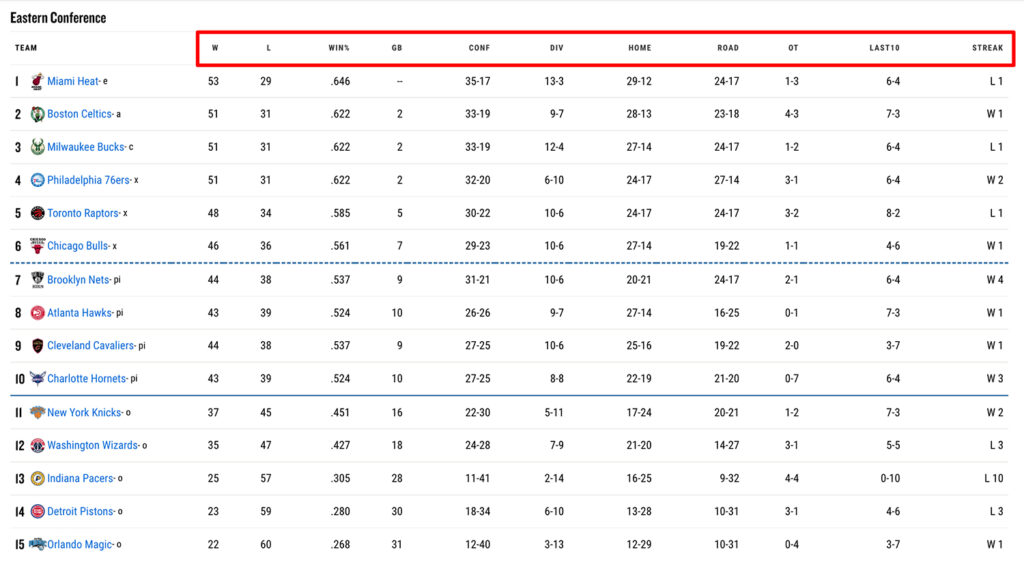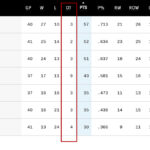The official NBA Standings consists of 12 columns, not just the team record for Wins and Losses.
Most of the additional columns play a role in ranking teams in the standings, especially if they have similar win-loss records.
For those that play a role in the standings, I explain how. And for those that don't, I point them out.
Furthermore, I provide examples, tables and describe the level of importance for columns when it comes to tie-breakers. That is, who finishes ahead in standings when teams are tied in the point system.
Have you ever asked yourself why a team finishes ahead of another? I break down these rules employed by the NBA in detail.
Continue reading for the answers or use the table of contents below to skip to your preferred column description.
Team - Team Name (Rank Status)
The team column simply consists of every team name along with their location.
For the most part, locations are represented by the city name, but there are exceptions such as the Indiana Pacers and the Utah Jazz.
Their arenas are located in Indianapolis and Salt Lake City, respectively.
As for the Golden State Warriors, "Golden State" is a nickname for the state of California. The team currently play their home games in San Francisco.
Towards the end of the season, letters start appearing next to the name of each team. These letters represent the rank status for each team in regards to playoff qualifications.
Teams that clinch conference or division titles are all guaranteed playoff spots.
I've included the complete Rank Status glossary below:
| Rank Status | Description |
|---|---|
| x | Clinched Playoff Berth |
| w | Clinched Western Conference |
| sw | Clinched Southwest Division |
| se | Clinched Southeast Division |
| o | Eliminated from Playoffs contention |
| nw | Clinched Northwest Division |
| a | Clinched Atlantic Division |
| pi | Clinched Play-In Tournament |
| e | Clinched Eastern Conference |
| p | Clinched Pacific Division |
| c | Clinched Central Division |
W – Win Column
Each team win is added onto Win column, regardless if the team won in regulation or overtime.
L – Loss Column
Losses are added to the Loss Column for both regulation and overtime losses.
Win % - Win Percentage (PCT)
Win Percentage is the portion of wins earned from the total games played per team. PCT is reported as a fractional value rounded up to three decimal places.
We calculate the Win Percentage as follows:
PCT = Wins / Total Games Played
Total Games Played = Sum of all Wins + Losses
PCT = 50/82 = 0.610 (value rounded up to third decimal)
For more details about Win Percentage, make sure to check out my blog post on What does PCT mean in Basketball?
GB - Games Back or Games Behind
Games Back indicates how many games each team trails their first-place, divisional rival. Games Back values shift in increments of 0.5 per game played, per team.
When a trailing team wins a game, they reduce their game’s back deficit by 0.5 games.
If they are the top team in the division, they would expand their lead by 0.5 games.
Meanwhile, they’d increase their deficit by 0.5 games following a loss.
For a more detailed breakdown about the Games Back column, make sure to check out my blog post on What does GB mean in Basketball?
CONF – Conference Record
The conference record refers to a team’s record playing conference rivals (either Eastern or Western).
Take for example the Boston Celtics – they play in the Eastern Conference.
Any time they play against the Chicago Bulls or the Miami Heat, the match result will be added to the Conference Record.
For many years now, teams are scheduled to play their conference rivals for 52 games in the season.
In addition, the Conference Record can play a role to settle tie-breakers in the standings.
It is the 4th rule in determining the tie-breaking procedure whether for two-way or multi-way ties.
In the end, the team with the better conference won-lost percentage will rank higher.
DIV – Division Record
The division record refers to a team’s record playing divisional rivals. There are 6 divisions, three in each conference.
Eastern – Atlantic, Central and Southeast
Western – Northwest, Pacific and Southwest
Similar to conference rivalries, teams play a fixed amount of games against their divisional rivals each year – 16.
The Division Record may play a role to settle tie-breakers in the standings.
It is the 3rd rule in the tie-breaking procedure for both two-way or multi-way ties.
In the end, the team with the better division won-lost percentage will always rank higher.
HOME – Home Record
Home Record is a stat that monitor's the team's winning record for games played exclusively at their home venue.
The home record doesn’t play any role in determining team rankings.
However, it is used to measure the team’s strength of schedule.
Teams with more home games left are considered to have an easier remaining schedule.
Playing in front of home crowd and the absence of travel make for better playing conditions.
As a note, the higher the strength of schedule, the greater chance a team will finish lower in the standings.
This can help a team get a higher draft position the following season.
For more information, check out this link on a team’s strength of schedule.
ROAD – Away Record
Away Record reports a team's record for all games played on the road.
Similar to the home record, the away record plays no role in ranking for the point system.
Again, it is used for determining a team’s strength of schedule for their remaining games.
OT – Overtime Record
The OT column represents each team’s overtime record during the regular season.
The value displayed is made up of the overtime wins followed by overtime losses (i.e. 5-2 or 5 wins and 2 losses in overtime).
The Overtime Record plays no role in a team’s position in the standings.
Last10 – Record over last 10 games played (L10)
L10 is the record for a team in the last 10 games. Again, this is another stat which plays no role in team standings.
It’s likely used for sports gambling where the bettor may interpret that a team will continue or break their momentum.
Streak – Recent Winning or Losing Streak
While the L10 record tells you a story about the team's record in the last 10 games, you're not given the order of the wins or losses.
The Streak column slightly provides a more accurate picture. It stands for a recent team's streak for wins or losses.
For example, if the team's L10 was 6-4, the Streak stat might display a value of W6, meaning the team won their last 6 consecutive games.
Additional Columns
PF – Points For
Points For, also known as Points Per Game Scored, is the average number of points a team scores each game.
The value displayed consists of a number rounded up to one decimal place.
In combination with the Points Allowed, we are able to calculate the Point Differential.
As a note, the Point Differential (or Net Points) is Rule #7 in the tie-breaking procedure for both two-way and multi-way ties in the standings.
PA – Points Allowed
As just mentioned, Points Allowed (or Against), is the average number of points the opponents scored against the team in question.
The value displayed for Points Allowed consists of a number rounded up to one decimal place.
DIFF – Points Differential
The Points Differential is determined by difference between the Points For and Points Allowed for any given team.
The Point Differential (or Net Points) is used to settle the tie-breaking procedure between two or more teams.
The team with the greater positive point differential will rank higher in the standings.
The value displayed for Points Allowed consists of a number rounded up to one decimal place.
Final Thoughts
NBA Standings become very interesting around the last 10-20 games of the season.
When teams are battling for playoff contention, many scenarios can emerge.
Will the team ranked ahead seal the deal and take charge of their own destiny?
Can the team, looking from the outside in, clinch a playoff spot against all odds?
This can become very nerve wracking.
And what if two or more teams finish with the same record in the standings? We’ve covered some of those scenarios above.
But click on the Official NBA standings and scroll to the bottom of the page for all seven official tie-breaker rules.






